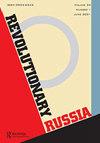Telling the Civil War in Nikolai Aseev’s Semën Proskakov
IF 0.2
2区 历史学
Q2 HISTORY
引用次数: 0
Abstract
The ten-year anniversary of the October Revolution in 1927 was celebrated across Soviet society, but scholarship on the anniversary lacks detailed analysis of the literary contributions to the celebration. This article presents analysis of Nikolai Aseev’s 1927 poema (narrative poem) Semën Proskakov in terms of its relation to the anniversary and ongoing attempts to formulate memory of the revolutionary past. It treats the poema as a narrative of the civil war told partially through accounts of actual participants and partially as a fictionalized rendition of these stories. Highlighting adherence to and deviation from source material, the article argues that while the Lef theory of factography provided a basis for Aseev’s narration of the civil war, it did not preclude inscription of historical figures into literary paradigms prevalent in Soviet literature at the time.从尼古拉·阿塞耶夫的《普罗斯卡科夫》讲述内战
1927年十月革命十周年纪念在苏联全社会举行,但关于周年纪念的学术研究缺乏对庆祝活动的文学贡献的详细分析。本文分析了尼古拉·阿西耶夫1927年的诗歌(叙事诗)Semën普罗斯卡科夫与周年纪念的关系,以及对革命过去的记忆的持续尝试。它把这首诗看作是对内战的叙述,部分是通过真实参与者的叙述,部分是对这些故事的虚构再现。文章强调了对原始材料的坚持和偏离,认为虽然左翼因素学理论为阿西耶夫对内战的叙述提供了基础,但它并不排除将历史人物铭刻到当时苏联文学中流行的文学范式中。
本文章由计算机程序翻译,如有差异,请以英文原文为准。
求助全文
约1分钟内获得全文
求助全文

 求助内容:
求助内容: 应助结果提醒方式:
应助结果提醒方式:


